GRACE AND GRATITUDE

The word “grace” has always been a mystery to me. Here is what Bahá’u’lláh says about it.
“His grace encompasseth all who have been called into being and been clothed with the robe of life.”- Gleanings from the Writings of Bahá’u’lláh.
I interpret this passage as God providing grace for those of us who strive to find answers about themselves and about life. However, is there a meaning for grace? Coming from a Christian background, I found this definition of grace… Christians believe that grace is “a spontaneous gift from God to people – “generous, free, and totally unexpected.”
Putting Bahá’u’lláh’s thoughts together with the Christian definition, I understand grace to be gifts from God given to me throughout my entire life, those episodes that I never thought were significant, ones I have even forgotten, yet as I have aged, looking back now, oh, what an appreciation I have for them now!
This is what my brief memoirs are about, describing the gifts from God I received while I was with you and showing my gratitude to the Malaysian and Brunei Bahá’ís for them. I hope we can walk down memory lane together with the recollections I have written about during those extraordinary times we had with each other. As I moved into my twilight years, I realize now that those graces of God, those decisions we made, changed our lives forever, as Robert Frost, the poet, says in his poem:
Two roads diverged in a wood,
and I took the one less travelled by,
And that has made all the difference.
I strongly believe that God has watched how I have tried to “do the right thing.” I feel this sincere striving, opened up the “flood gates” of God’s grace to me even though He knows that, at times, I have not always been a perfect human being.
Looking back on the grace of our earlier life experiences, those chance encounters and what seemed to be ordinary events, all contributed to our spiritual rebirth, our becoming part of the extraordinary worldwide Baháʼí community. I realize now that those early spontaneous and unexpected life experiences were the miracles that have affected all of us, guiding us into the wonderland of the Baháʼí Faith.
I am so grateful for my small contribution to the Malaysian and Brunei Baháʼí communities during those formative years when we were sharing so much together. There is no doubt in my mind that without my early life experiences, before my Southeast Asian experiences, I probably would be still in Chicago, clueless about Malaysia and the Baháʼí Faith. From my heart, throughout my memoirs, I again want to thank the Baháʼís in Malaysia and Brunei for our relationship together, for their gifts of love, guidance, and friendship at a time when I had just accepted the Faith. It was their love, guidance and friendship that nurtured me in the Faith.
Early Days in Chicago
The unexpected favours came to me on the South side of Chicago. They set the stage for my journey to Malaysia and laid the foundation for my becoming a Baháʼí. I grew up on the campus of the University of Chicago, which exposed me to international cultures, ethnic groups, and diverse points of view. My neighbours lived in unity, striving to work together toward community goals. It was so natural for us to mingle, to share ideas and enjoy each other’s company. I also went to a high school which was 85% Black, which also gave me a soulful perspective on life, all of which prepared me to accept the unity of mankind when I heard it humbly spoken, for the first time, deep in the jungles of the state of Sarawak, which is part of Malaysia.
Growing up in a dysfunctional family put me into what I call “survival mode,” fleeing the pain around me, forcing me to leave my family when I was sixteen years old. Yes, it was a painful gift; nonetheless, it was grace from God. Those heart-breaking times contributed to my preparation for the Baháʼí Faith. With fear inside and the insecurity that I developed, I naturally sought love, through surrogate families during my early days. From an Italian Catholic family who took me to church on Sundays, to a Jewish family who taught me how to pray, onward to a Mexican family who showed me how to love, not to mention the Black family who gave me the strength to believe in myself. Thinking back, each family saved me from careening down a path to destruction.
At the end of my high school years, I was drifting without any direction in life. Then, I decided to go to university. It was a mistake at the time because I was unprepared for the rigors of academic life. I even dropped out of university twice. What made it more discouraging was I was given an I.Q. test, at that time, which indicated a low score. I remember the painful words of the young psychologist, who advised me, “It might be better not to pursue a college education.” Between the trauma of a dysfunctional family and this heart-wrenching reality, I fell into a deep depression. I am not sure how I overcame this dark episode in my life, but, somehow, I managed to pick myself up to continue on my Spiritual path.
Would you call this experience in my life, Grace, a gift? Looking back, I feel now that because of the traumatic episodes in my life, I am capable of opening my heart to others, showing them compassion, empathy and respect, no matter what their life circumstances.
Somehow, with this chapter in my life behind me, I regrouped, as they say, attending Junior College and eventually graduating from a university designed for dropouts like myself. After graduation, I found a job as a social worker in one of the worst ghettos on the West side of Chicago, again giving me a view of life that opened my eyes to the injustices affecting the Black community.
That was how I was unconsciously preparing for the three oneness – oneness of God, oneness of religion and oneness of mankind. I experienced the oneness of God and religion in the diverse families and groups I experienced and realized very soon how similar we all are inside, striving to improve ourselves, seeking happiness, desiring respect, and searching for that “Golden Fleece,” a meaning in life that was still a mystery to me before I travelled to Malaysia.
Assignment Malaysia
In 1970, I joined the Peace Corps, an independent agency and volunteer program run by the United States Government providing international social and economic development assistance. The program was established by the late American President, John F. Kennedy. Many American youth went overseas to offer their enthusiasm and expertise to underdeveloped countries. I was first assigned to go to the Philippines. Then, God intervened when there was a unexpected change in the domestic political situation in the Philippines. The Peace Corps reassigned me to go to Sarawak at the end of 1970, guiding me down a new path that would change my life forever. I worked in the First Division of Sarawak, East Malaysia as a Primary School advisor until 1972 when I was offered a job in Brunei in 1973.
I Found the Baháʼí Faith
I found the Bahá’i Faith in a Dayak longhouse deep in the jungle of Sarawak. The Dayaks are one of the native groups living across northern Borneo and in Sarawak state as well. As a Peace Corps volunteer, I would travel to jungle schools, showing teachers how to teach. One evening after classes, I remember sitting in a circle in a longhouse with some Dayak friends and a Bahá’i travel teacher, Mr Kupusamy, from West Malaysia. Kupusamy and the Dayak friends spoke of the “The Three Onenesses,” pointing to a large poster of a temple that was pinned on a bamboo longhouse wall.
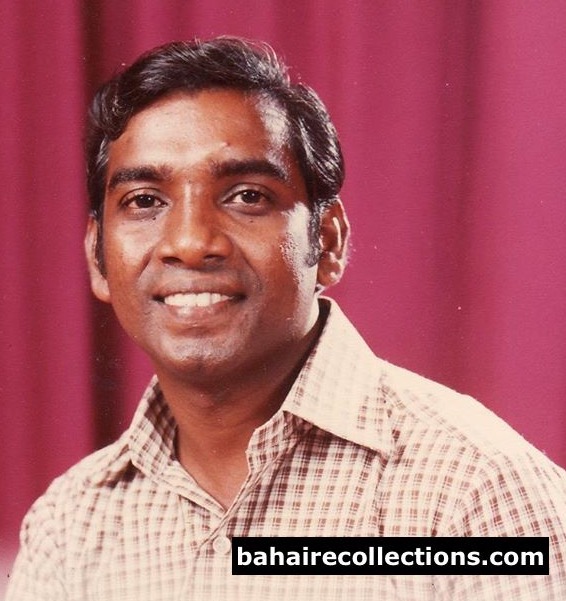
Kuppusamy, my spiritual father
I was mysteriously attracted to the poster, getting up from my friends to take a closer look. I stood before it in awe, somehow knowing it, sure that I had seen this beautiful temple before, somewhere in my past. One Dayak man in the circle shouted out to me in the Malay language, “Itu Bahá’i Temple,” which means, “that is a Bahá’i Temple.” Bahá’i, I wondered, does he mean B’ni B’rith, the Jewish organization that serves mankind? This is why I first thought that this poster of the Baháʼí temple on the bamboo wall was a Jewish synagogue! I was shocked! How did a poster of a Jewish temple find its way to an isolated and remote village in the deep jungle of East Malaysia?
Then I saw the print at the bottom of the poster. I squatted down to take a closer look, squinting to read the words in the low-lite longhouse – “Bahá’i Temple, Wilmette, Illinois.” Reading this, the shock caused me to bolt up in recognition of the temple, surprised heads turned towards me in the circle of friends!
I remember, shouting out loud, “I know this temple!” I exclaimed, staring at the poster for some time. Of course, back in Chicago, I used to cycle by it from the South side up North to Wisconsin. Why I never went inside the Temple is still a mystery to me. I realize now that I had to travel 12,000 miles away from Chicago to find my destiny. Then, suddenly, I came out of my trance, out of the power this temple had over me, turning to my friends sitting in the circle, asking, “What did you say a Bahá’í was?” Thank you Kupusamy and the loving, kind, open-hearted Dayak people, who were only too glad to give me an introduction to the Bahá’í Faith!
You see, the divine timing was perfect! I was at the same longhouse that Kuppusamy was teaching! Was it a coincidence, nay, it was Baháʼu’lláh’s grace, His radiance directing me to my salvation!
Getting to Know the Baháʼí s in Kuching
Well, that was my introduction to the Faith in the beginning 1971. The East Malaysian Bahá’is in town areas took over teaching me more about the Faith. My mind was in turmoil with questions that Kupusamy did not have enough time to answer, but he did give me the address of one Dr. John Fozdar. So, after returning to Kuching city, the capital of Sarawak state, I immediately went to Dr. John Fozdar’s clinic. I remember waiting there in the reception area while my mind was reeling, uncertain about what I was getting myself into. Then, Dr. Fozdar came out of his office. I did not even see him at first. I remember bending over deep in thought, with hands propping up my head with a million questions going through my young mind.
It was Dr. Fozdar touching my shoulder that startled me out of my thoughts. I looked up, seeing his angelic smile, a smile that greeted me every time we met at his home, at firesides, deepening sessions and at the delicious meals we had at Bahá’í events. Every time I came back from my job in the jungle, Dr. Fozdar would tutor me about the Faith. This went on for several months. Thank you Dr. Fozdar for your loving intellectual embrace!
I came to learn that Dr. John Fozdar pioneered to the country of Brunei in 1954, by which he became one of the three Knights of Baháʼu’lláh. There were two other pioneers who arrived in Brunei in 1954 and became Knights and they were Mr. Harry Clarke, and Mr. Charles Duncan. I was told that Shoghi Effendi, the Guardian of the Bahá’í Faith, was happy that Dr. John pioneered to Brunei. Oh my God! Later I would also pioneer to Brunei. I was flushed with joy thinking of the same paths that the three Knights of Bahá’u’lláh had walked.
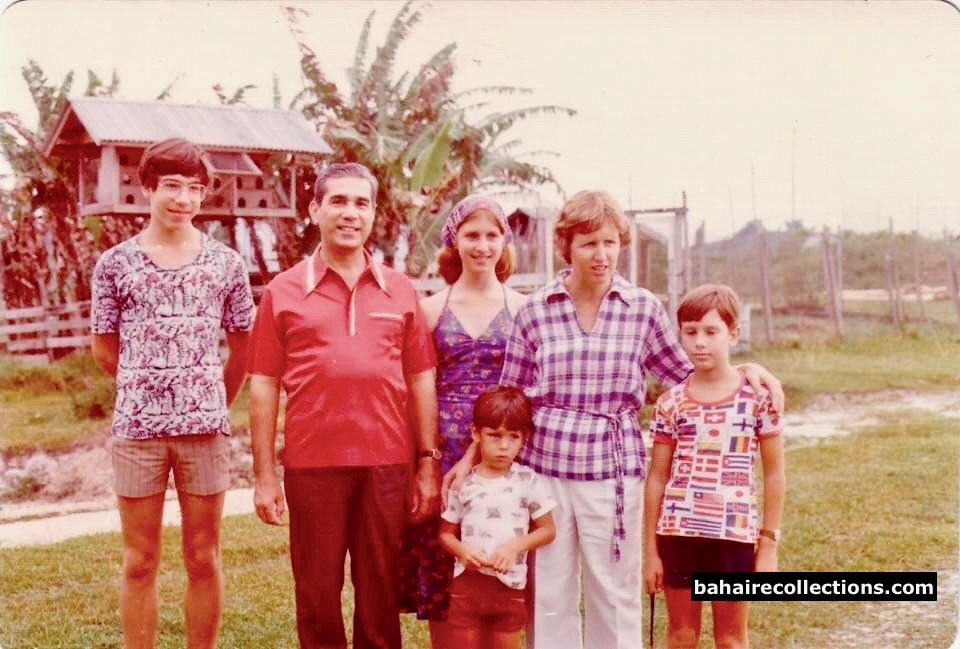
Dr. John Fozdar with family. L-R: Kamal Fozdar, Dr. John Fozdar, Shirin Fozdar and Grete Fozdar flanked by Ian on right and Roy on left. Photo takenin 1975 at Selalang near Sarikei, Sarawak.
At Bahá’i activities, I met the young, smiling, and friendly Bahá’i youth who welcomed me into their circles. I attended firesides, where I was overwhelmed at the truths I heard about the equality of mankind, other religions, and the independent search for truth. When I first heard these teachings of the Faith, my mind rushed back to the neighbourhood I grew up in with some similar beliefs of unity that were not taught to me, but I lived them with the diversity of religions and peoples who were an integral part of my life.
It was easy for me to accept the Bahá’í Faith and learn to love the Bahá’is in Kuching. I came to trust them, opened up to them, laughed with them, had serious conversations, went out for meals together, took the youth out to the nearby longhouses to teach the Faith. Indeed, the most fun came when we sang Bahá’í songs, “I got the Bahá’í spirit right on my head!” Thank you, you fun-loving and enthusiastic youth of Sarawak!
I looked forward to being with the Bahá’ís as their company enhanced my spirit. My Chicago fears, insecurities and suspicions of people simply vanished in thin air. The love of the Sarawakian believers for me touched my heart, a feeling I had never experienced in Chicago. Again, thank you young, soldiers of Bahá’u’lláh!
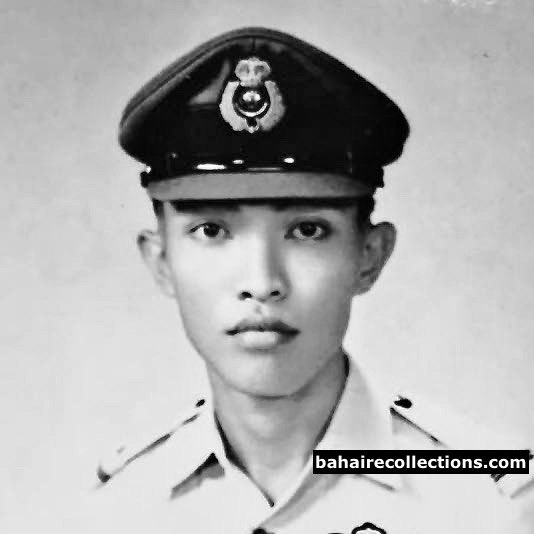
Captain Choo Yeok Boon, a believer of spotless character
There were so many Baháʼís in Sarawak who encouraged me, touched my heart in so many ways. I remember Captain Choo Yeok Boon, whom I befriended in Sarawak in 1971. We connected right away with the direct way he communicated with people. He was quite different from other Baháʼís. He spoke frankly, not holding back the truth. We were “soul brothers,” talking about everything under the sun. I remember his energy, his engaging smile and his “in-your-face” attitude, which convinced more than anything when he said to me, “If you can find any religion better than the Baháʼí Faith, then follow it!” That statement provoked my soul. I was crushed when I heard about his passing when a helicopter, that he was piloting, crashed in 1976. Thank you Boon for your friendship, directness and love.
West Malaysian Baháʼís
The love showered upon me did not end in Sarawak because I would later travel to Kuala Lumpur, the capital city of Malaysia in West Malaysia, the coastal town of Port Dickson and the neighbouring country of Singapore to the south of West Malaysia. It was in Singapore that I officially accepted the Bahá’í. It was at Singapore’s first Baháʼí Winter School in December 1971 that I met Miss Yaw Kam Sim, my wife for 44 years. She was serving as the Manager of the Malaysian Bahá’í Bookshop in the National Bahá’í Centre in Kuala Lumpur. Kam Sim and another lady of Indian background Kamachee came up to me to introduce themselves. I have to laugh now because they gave this white man the third degree! “Do you drink, smoke, or take drugs?” Well, I guess I passed the test because Kam Sim and I connected, and shared letters over the months. She was in Kuala Lumpur, and I was in Brunei which made it difficult to “tie the knot,” as they say. What made it even harder was our paths separated even further when Kam Sim pioneered to Mozambique. It seemed at that time our relationship would end with me in Brunei and Kam Sim in Mozambique.
Spirituality Unleashed
I remember teaching in Singapore in 1971 with those exhilarating youth after the Winter School! Our enthusiasm and boldness had no bounds. Walking up to strangers and exhorting, “Have you heard of Bahá’u’lláh?” A bewildered stare or an answer “Never before?” Our exuberance opened their hearts!
We were without doubt, inhibitions, or fear. We could not fail! We walked down the famous Orchard Road in Singapore singing “We got the Baháʼí spirit right in our hearts!” We had laughed, walking shoulder to shoulder singing, “We are the people of Baha!” Our belief in Bahá’u’lláh transformed us to speak His wisdom.
It was Yankee Leong who emphasized when he said, “Just make sure you say His name, “Bahá’u’lláh.” “That will be the magic! “We deeply believed that intonation was enough to touch people’s hearts. It did, not intellectually, instead through their spirits directly to their souls. We bubbled with joy, conveying the three onenesses which was enough for us and for them as an introduction. Are you sure Yankee Leong was at the winter School? No, but this paragraph doesn’t say he was in Singapore, but I received advice that I heard from different Bahais, and I am certain Yankee said this to me! (Delete)

Yankee Leong, a saintly soul
It was our spiritual vibrations that united us. We were angels from the Abha Kingdom. We felt a mystical connection and love for each other that made us irresistible. We forged ahead; we were connected to the spiritual realm. We were divinely guided with certitude, with a message from our Creator.
I learned from the Baháʼís in Singapore with their uninhibited approach to teaching. Their fervour was from the depth of their souls and their authentic selves. Do we teach differently today with Ruhi classes, our firesides, study circles and our individual encounters? However, we teach, like the Baháʼís then, we should teach with passion, joy, and ardour.
I became a Bahá’i
How did I signed the enrolment card to become a Baháʼí? Here is how it happened. After the Singapore Winter School in 1971, along with all of our pent up Spiritual energy, several of the Singapore youth went teaching on the streets of Singapore. At the end of the day, and still in rapture from our teaching, everyone went to the to the Singapore Baháʼí Centre, where the Nineteen Day Feast was about to take place.
We were so young, uninhibited, and passionate that evening, experiencing the same spiritual energy that we felt while teaching on Orchard Road.
My love for the Baháʼís was bursting. But alas, I came to know I had to leave because, at that time, non-Baháʼís did not attend Nineteen Day Feasts. I did not want to leave. In my heart, over and over again, I said to myself, “Sign the card. Sign the card!” that I saw in Kuching, but I was afraid, confused and could not follow my heart like I should have during the first year I was taught the Faith.
At the Bahá’i Center, Kupusamy, my “spiritual father,” as Bahá’is affectionately describe as the first teacher of the Faith, in a Dayak longhouse in the jungle no less, was also in Singapore. He came up to me, hugged me, putting an enrolment card in my hand. He did not try to change my mind, but said, “Take it, look into your heart about becoming a Baháʼí. God will guide you.” I had tears in my eyes as I was leaving, as the Nineteen Day Feast was about to begin. I had my motorcycle with me, which I had brought from Sarawak. I got on my motorcycle and rode away from a loving experience that I had never experienced before in my life. Deep inside, my heart was reeling with pain that I was making the biggest mistake of my life. As I was driving my motorcycle away from the Baháʼí Centre, something mysterious happened.
My motorcycle just stopped a couple of miles away from the Baháʼí Centre, just like that! No matter what I did, I could not start it.
There I was under a streetlight away from everyone, 12,000 miles from Chicago. I gave up trying to start my motorcycle. Just sitting on it, feeling sorry for myself, almost in tears, I did not know what to do. Then the streetlight started flickering. I looked up and each time it flickered, going off and going back on, I saw that the streetlight brightened, even glowed, when it turned back on. I was mesmerized by this strange occurrence. “What did it mean?” After some time, I reached in my pocket, feeling the enrolment card. It was like a lightning strike. I knew what I had to do. I took a deep breath, said the Remover of Difficulties prayer which I had memorized by then, and signed the card, without hesitation, right there on the street! Staring at it, I was elated and relieved. Yet I was stranded since my motorcycle was dead. What was I to do? So, I started pushing the motorcycle back to the Centre.
It was a big motorcycle. The weather was hot and after pushing it for a while, I stopped to rest, thinking why not try to start it one more time. I mounted my bike, gave one strong kick to start it. It was music to my ears when I heard the roar of the engine! I remember the feeling of rapture rushing through my body as I sped back to the Baháʼí Centre. I entered, right in the middle of the Nineteen Day Feast running directly to Kuppusamy to tell him I had signed the card. What a gratifying reaction from everyone in the room. There was happiness and ecstasy that went through all of us. Everyone congratulated me with hugs, smiles, and even kisses. There are only a few episodes in my life that have been so emotional and momentous as that night when I became a Baháʼí. Thank you Kuppusamy for your confidence in me and the passionate Singapore Bahá’ís.
The extraordinary month of December 1972
In early December 1972, before I started my new job in Brunei, I went to West Malaysia to say good-bye to my friends in Kuala Lumpur. What an extraordinary series of events I would experience in that month, which began when I met Mrs. Elizabeth Gibson and her family. Her husband was based in Vietnam while she was in Kuala Lumpur and serving on the National Spiritual Assembly. It was she who informed me about Mr. Jenable Caldwell from Alaska who was about to offer his Nine-Day Spiritualization Program in Stella Maris bungalow in the coast of Port Dickson town. As a new Baháʼí of only one year, I felt I was not worthy or ready to attend such a Baháʼí gathering, especially with such notable Malaysian Baháʼís who were to attend. However, she insisted and I eventually gave in to Bahá’u’lláh’s grace.
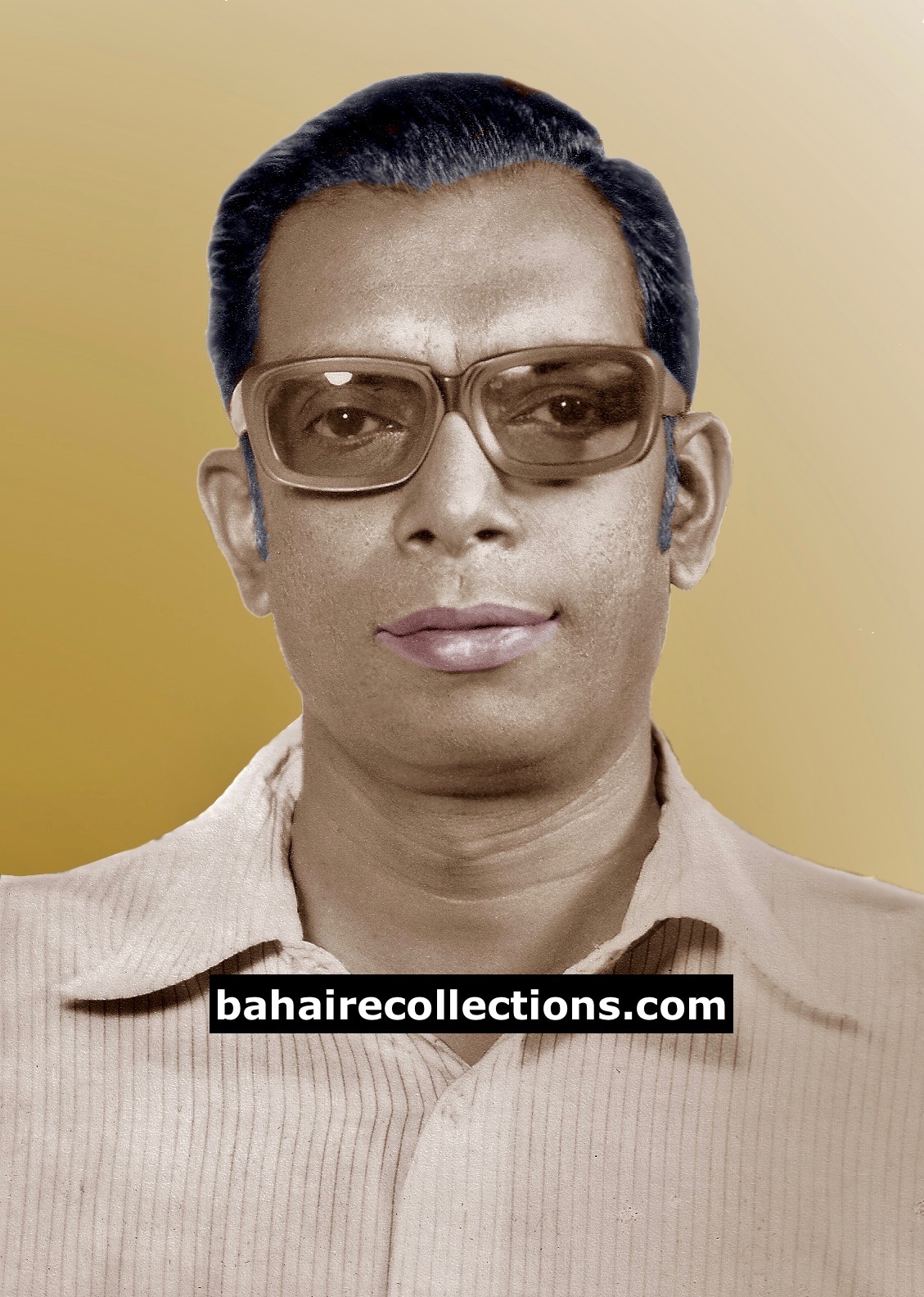
Inbum Chinniah, truly a jewel among men
While I was visiting Kuala Lumpur in 1972, everyone knew I was going to start a new job in Brunei. At the National Baháʼí Centre in Kuala Lumpur, Inbum Chinniah who was the Secretary of the National Baháʼí Centre came to me. I cannot remember exactly what he said to me. I always remember the feeling I got when I talked with Inbum. It was his spirit that touched me and the way he joked about his “carburator problem.” We talked, yes, but we talked with our hearts; there is no other way of describing it. At one point, he said, “Matthew, can you pioneer to Brunei for the Malaysian Baháʼís?” I stared into his glowing eyes, sensed his sincerity and, “Well, how could I say no?” His reaction said it all with a hug that consumed me, going right into my soul, causing me to tear up. Afterwards, he rushed around the room telling each Baháʼí about the new pioneer among us. I wish I could have gotten to know Inbum better. There are so many “what ifs” I wanted to do, but in my heart I did my best.
Thank you Inbum for your loving, heartfelt
encouragement! Gratitude also goes to the
West Malaysian and Singapore Bahá’ís,
especially for Yankee’s loving, magical
intensity.
Just a thought about and Inbum, who came into my short Malaysian Bahá’i life for only a few intense episodes. Yankee was older but he had the spiritual enthusiasm of a youth that gave us the courage to teach. Yankee had a radiance, a glow that manifested itself in his personality through his smile and those inviting eyes. Yankee Leong was the first believer of West Malaysia and a member of the Continental Board of Counsellors for Southeast Asia. As for Inbum Chinniah, if you ask any Bahá’i in West Malaysia, their eyes will widen with love when they describe their esteem for Inbum. He was the Secretary of the National Spiritual Assembly of Malaysia. These two luminaries also came for the Winter School in Singapore.
Spiritualization Course
After my short stay in Kuala Lumpur, I started Jenabe Caldwell’s inspiring, not of this world, Spiritualization course. I felt inadequate as an inexperienced Baháʼí. I soon found out though that the course was not an in-depth intellectual study of the Baháʼí Faith; instead, the focus was giving our heart-felt thoughts about prayers, meditations, and other Baháʼí Spiritual writings. There were no wrong answers. We began with a round of the “Remover of Difficulties” prayer each day. Then we would read one of the writings. From that point on, each one of us was required to share his inner thoughts. It was astounding the Spiritual shares that each one of us gave. We were no longer speaking with our intellects, but we were expressing our thoughts from our hearts, creating a heightened spiritual intensity, a spiritual rapport among us and a feeling that a power greater than ourselves was with us, guiding us, holding our hands as we gave overwhelming shares that brought tears, on many occasions, to each of us. Thank you the magnificent group of Bahá’i friends and Mr. Caldwell for challenging us to think with our hearts.
 First Nine-Day Spiritualization Institute in Port Dickson. Sitting L-R: Lily Ng, Rajambaal Nagaratnam, Theresa Chee, Yankee Leong, Dawood, Jenabe Caldwell, Shantha Sundram, Betty and Lily Chinniah. Standing L-R: R. Ganasa Murthi, Nita Tahmasebian, Koh Ai Leen, G. Appala Naidu, Nagaratnam, Dr. M.M. Sreenivasan, Mathews Wagner, N. Nagendran, Kenneth Mak, Dr. M. Singaravelu, M. Ganesan and Ramu Naidu.
First Nine-Day Spiritualization Institute in Port Dickson. Sitting L-R: Lily Ng, Rajambaal Nagaratnam, Theresa Chee, Yankee Leong, Dawood, Jenabe Caldwell, Shantha Sundram, Betty and Lily Chinniah. Standing L-R: R. Ganasa Murthi, Nita Tahmasebian, Koh Ai Leen, G. Appala Naidu, Nagaratnam, Dr. M.M. Sreenivasan, Mathews Wagner, N. Nagendran, Kenneth Mak, Dr. M. Singaravelu, M. Ganesan and Ramu Naidu.
The final uplifting gift came after the spiritualization course in Port Dickson, when I attended the Winter School in Johore Baru. It was a bitter-sweet experience with the fun we had together, the in-depth studying of the writings that inspired us and the excitement that builds, which every Bahá’i knows, who has attended a Bahá’i event like this. At the end of the winter school, I said my good-bye with everyone wishing me well with my pioneering to Brunei.
Final Farewells to Sarawak
Soon after I returned to Sarawak. Dr. Fozdar asked Kuppusamy and me to conduct a shortened version of the spiritualization course. Again, it had the same effect on the youth that attended. Over the next couple of years, the spiritualization course was given in West and East Malaysia. Thinking back on the spiritual power it invoked in Baháʼís who attended, I always wondered if this spiritualizing effect of this course was a contributing factor to the phenomenal success of the Malaysian Baháʼí community.

First few friends at Ranchang Pool, Kuching 1973. L-R: Shirin Fozdar, Mathew Wagner, Kamal Fozdar, Captain Choo Yeok Boon, Gladys Chiong Kai Soon, Cecilia Tay and Christine Chan
Looking back on the spiritualization course, it has helped me to study the writings with a spiritual eye, one that goes beyond words into the realm of the spiritual mystery, the closeness to God, that Bahá’u’lláh insists is the goal of studying the Writings.
Pioneering to Brunei
At the end of December, I took a rickety old cargo ship along the coast of Borneo to Brunei where I started pioneering. However, when I travelled to the school, where I was supposed to teach at, I got the surprise of my life. The assistant principal didn’t know who I was nor that I was promised a job at the school! I thought my time in Southeast Asia had finished. I was devastated. Then, they called for Hans Rottinghus, the newly appointed principal of the school. He was a towering figure, a large Dutchman with presence. When he came into the office, he sized up the situation, saw the dejected white man in the room and said, “Are you Matthew Wagner?” What a relief. It was he who hired me without telling anyone else.
Oh, how I must stress that the Brunei Baháʼís cemented my love for the Faith. There are no words that can describe the loving relationships that pioneers have for one another. We shared so much in our love for the Faith. We were so close. I was the closest with Mr. Rusi Irani and his wife Qudsiyeh from India who pioneered to Brunei ahead of me. Rusi Irani was working in the Electrical Department of the Government of Brunei. Every time I visited him in Bandar Siri Begawan, the capital of the country, we connected in a way that bonded our hearts in unity. Thank you Rusi for the wonderful conversations we had.
Mr. Chin Yun Sang and his family were the pillars of strength for the Brunei Baháʼí community. Every time I went to Bandar Seri Begawan, Mr. Chin insisted that I visited his family. We all participated in devotionals and firesides at his home. His home was a haven for us. Mr. Chin had certitude and spiritual force, an example for all of us, because at that time, there was no total religious freedom in the country. His inner strength and confidence empowered all of us to focus on what was important for Brunei Baháʼís and that was our inner striving to be inspiring examples that `Abdu’l-Bahá would be proud of. Thank you Mr. Chin for your focus, your steadfastness and accepting me into the Brunei Bahá’i family.
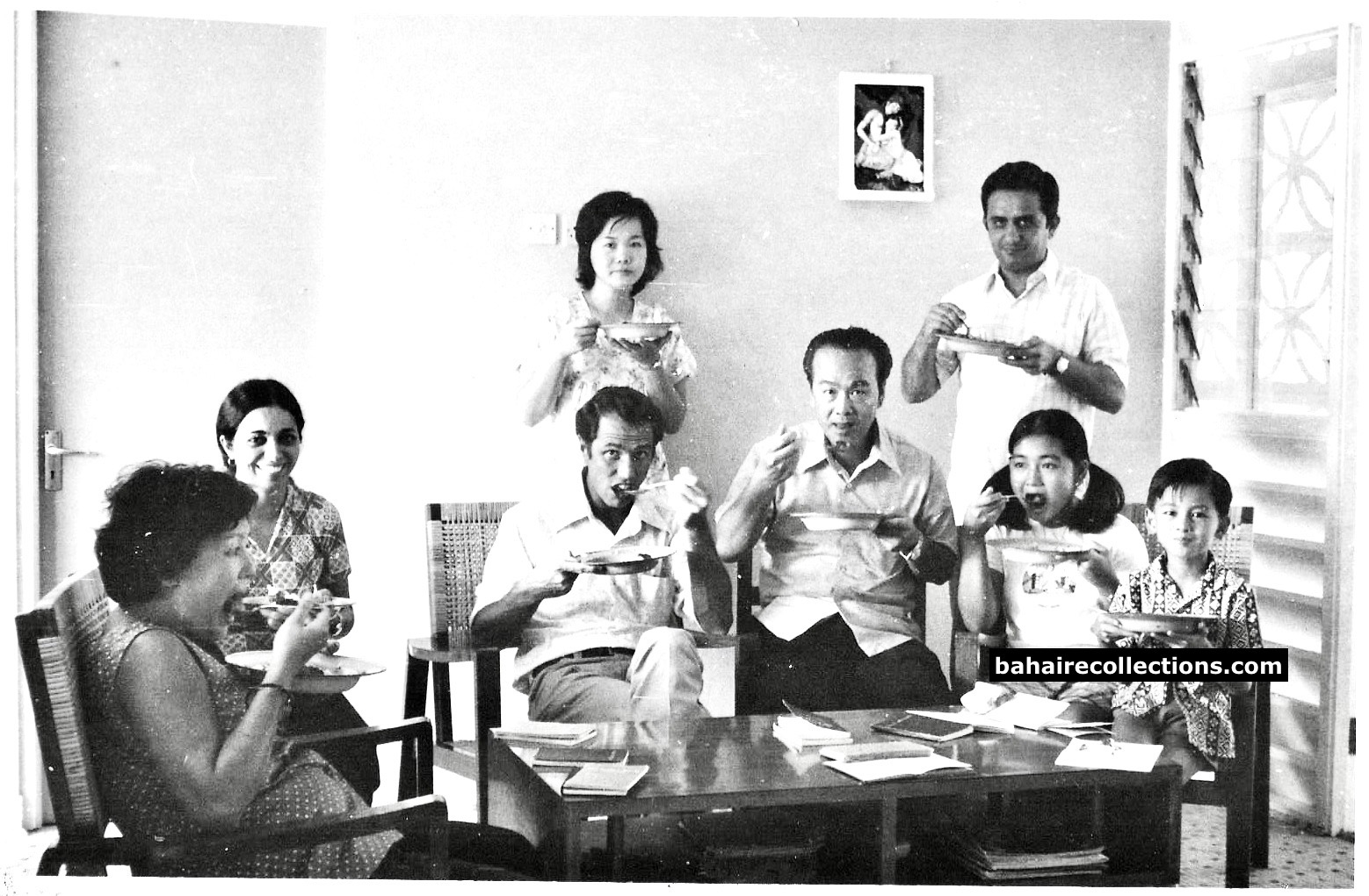
Lunch after a deepening session at the home of Rusi Irani. L-R: Mary Teo, the wife of Chin Yun Sang, Qudsiyeh, wife of Rusi Iraini, Mathews Wagner Wagner, Chin Yun Sang, Chin Swee Yung daughter of Chin Yun Sang and Vincent Chin son of Chin Yun Sang. Standing at left is Chin Nyuk Ching the youngest sister of Chin Yun Sang and to the right is Rusi Iraini.
The few Baháʼís who lived in Brunei went teaching together in the rural areas because we could not teach freely in town. We also had wonderful gatherings at the Baháʼí Centre in Bandar Siri Begawan and Baháʼís from there would often times visit my home in Seria where I lived. When they did come to visit, we would go out to the Baháʼí cemetery to cut the long grass, which quickly grew there. I remember we sang Baháʼí songs together as we worked, running away, on one occasion, from a large Komodo dragon.
The land for the cemetery, located in Seria, Brunei, had been given to Dr. John Fozdar by a friend, Penghiran Abu Bakar. Dr. Fozdar’s son is buried there, who died prematurely.
There were also times when Baháʼís from the jungle villages would pass through on their way to the town of Miri in Sarawak. I would come home from the school where I worked to find a rural Baháʼí, only in a loin cloth, sitting outside in the front of my house. They were such good-hearted people. Of every Malaysian I met, I was impressed with them the most. They were so loving, kind, humble and without any sense of ego. I had many non-Baháʼí friends in Seria, who sang singalongs together. I remember how one of my rural jungle friends sang along with us in the Dayak language, did a Dayak joget dance for us and literally laughed out loud with joy at our singing throughout the singalong! Thank you Dayak people of Sarawak for lifting my spirit, making me laugh and teaching me how to be humble.
Another event in Seria also concerned singing. Every year, St. Michael’s High School, where I taught, would participate in an outdoor fair when different schools in the area would create displays with different educational themes. I was the choir director for the school. At the Fair my students sang inspirational songs, Black Spirituals and, of course, Baháʼí songs, ones without any direct reference to the Baháʼí Faith. One song I learned in Kuching was a Native American song,
Hey Ney Yah Ha Na, Hey Yah Hey Yah Ha Na….
I walk in Beauty yes, I do…yes, I do, yes I do…
We were singing this song, when the Sultan of Brunei, who often frequented the school fairs, walked by. He stopped to listen and to ask questions about the choir and the origin of the song we were singing. Well, as my daughter used to say when she was young, “I freaked out,” but gained enough composure to tell the Sultan the truth that the song was Navajo, originating from the Southwestern United States. He seemed very pleased with my explanation.
In my last year when I applied for renewing my work permit in Brunei, I was shocked that I had to wait for six hours, which normally only took an hour. I understood later why I waited so long. I could stay another year, but I knew from what I heard from my Headmaster at St. Michael’s high school that my visa would be rejected the next time I applied. I remember the sad times when a group of us would send off Baháʼís at the airport, saying good-bye to them, knowing they would never return, a heart-breaking moment for us. And later I was one of them, sent away with tearful eyes, ending my pioneer days. Thank you Brunei Bahá’ís for the loving intimate fellowship we had as pioneers.
A Short Medley of Travel Teaching
When I finished pioneering to Brunei, the National Spiritual Assembly of Malaysia asked me to teach as I made my way back to the United States. I began travel teaching for the Malaysian community over a period of five months in 1976 on my way back to the United States. I tried to travel overland, as much as I could, with such transportation as buses, trains, boats (easier to teach) and occasionally I had no choice but fly, especially when I wanted to travel through the Middle East. I first travelled taught through Southeast Asia to such countries as Thailand, Burma, Bangladesh into India over to Iran. I did so with enthusiasm by creating a map of Bahá’u’lláh’s exile from Iran to Baghdad, up into Turkey and down to Israel, that I brought to present in each country I visited. Here is a short medley of travel teaching experiences.
On a train up to Bangkok, Thailand from West Malaysia, I met an Artist who I taught the Faith to. While I was teaching, he drew a picture of religious symbols, all of which were directed, graphically, to the Baháʼí Faith. He then gave the drawing to me.
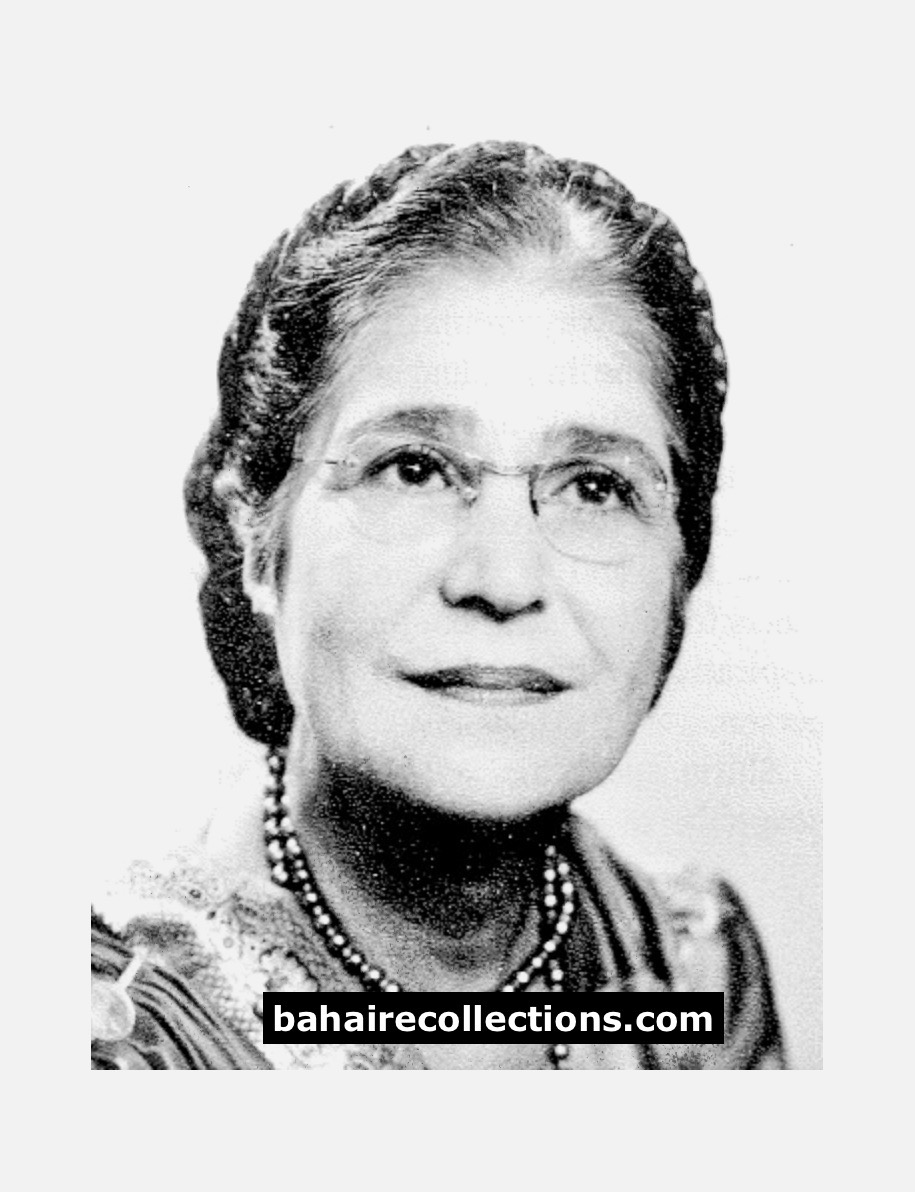
Mummy Fozdar
After a long train ride, I entered the city of Bangkok where the Bahá’í s youth met me, who were as enthusiastic as the Bahá’í s in Malaysia. I gave my talk to the youth about Bahá’u’lláh’s exile, attended Firesides with them and then met Mummy Fozdar who came into my life, who lived up to her reputation as being the matriarch of the Bahá’í s of Southeast. After meeting her, she would not let me out of her sight. I was touched by the intensity of her devotion for me and others. She was always telling me Baháʼí stories, giving me advice and reassuring me that I had a special destiny in the Faith. I also remember how she would hold my hand, squeezing it till it hurt, especially when she wanted to make a point about the Faith. I think she sensed my insecurity, wanting so much to show me that love was the answer. Thank you Mommy Fozdar for your love and concern for me!
In Burma, as I drove into `Abdu’l-Bahá’s village in Daidanaw, when a very large crowd of Baháʼí youth circled the jeep. I was in awe, as those youth greeted me with such cries of enthusiasm, which I’ve never forgotten.
In Nepal, I brought a Baháʼí book to a village at 14,000 feet in the Himalayan mountains. I discussed it with him and gave it to a Village elder, who put it among other religious books.
While traveling on a bus from India to Nepal, the bus had a flat tire. After everyone got out, I had an impromptu fireside with translations from English into Hindi swirling from one person to the next in a crowd of maybe 20 people.
I met the Baháʼí s in Iran, who secretly and quietly walked me through narrow streets of Teheran, pointing out a few houses where Bahá’u’lláh lived and taught the Faith.
While at the Teheran airport, just before boarding, I was with a group of Iranians going to Israel. I felt a sudden urge, an overwhelming inspiration to teach these Iranians, which I was advised not to do. I did so anyway thinking I would end up in an Iranian jail. The crowd gathered around, as I said, “have you heard of the Baháʼí Faith.” their eyes widened, exclaimed, laughing, “We are all Baháʼís on our way to our three-day pilgrimage!”
Petals and Pebbles from the Holy Lands
Describing my nine-day pilgrimage is difficult to describe because words are inadequate to describe express (delete) what is going on in the heart of a pilgrim. What I can say is the experience goes beyond words in the realm of spiritual mystery, which each pilgrim experiences in his own way. On the other hand, one does a lot of soul searching. During one of my meditations, my heart brought me back to the grace that had been given to me over the years with my Chicago experiences, which guided me to even more extraordinary gifts in Malaysia. This is when my heart went out to the Baháʼís in Malaysia who inspired me to break a rule.
The sad thought that came to mind was that they could not go on their pilgrimage at that time. I pondered this, thinking how many broken hearts there were among the Baháʼís who knew they could not have the Spiritual experience of a pilgrimage. Sitting there in the Gardens with these thoughts, my eyes were attracted to petals floating from rose bushes, from a higher terrace, on to the pebbles below and in front of me. It was not just one petal, but for some reason many, many petals rained down on my left and right, several settled on my lap, and some fell onto my shoulders. One even stuck to my forehead. It was not even windy at all.
Well, that’s when I got a flash of inspiration. Without hesitation, I bowed down to gather a hand full of rose petals along with pebbles. I had large pockets where I stuffed in as many of them as I could. I was trembling, knowing that I was breaking the rules, but I could not help myself. It was the end of the day, so I walked surreptitiously out of the Baháʼí Gardens, fearfully expecting a Universal House of Justice member to jump out of the bushes reprehending me for what I had done. I returned to the monastery, where I was staying, unable to sleep that night.
The monastery also had gardens where I spent several hours meditating on the grievous act I had done with the pebbles and petals burning inside my pockets. After the sun had gone down, I stood up, walked to the monastery office where the sisters worked, asking them for a small box. They found one that I gratefully accepted and returned to my room where I reverently placed the roses and petals into the box, sealed it and addressed the box to someone in Malaysia.
After my pilgrimage, I travelled to Jerusalem for a couple days, then took a ferry to Greece. It was in Greece from where I sent the sacred box to Malaysia. I certainly did not want to send it from Israel. My heart kept telling me that at least Baháʼís of Malaysia would have a small bit of holiness from the Baháʼí Gardens to cherish.
To this day, I do not know the fate of that box full of love. Over the years, I have hoped that it had arrived safely.
In Italy, where I caught “walking pneumonia,” I befriended a 90-year-old woman who worked at the hospice I stayed at. I taught her the Faith as she nursed me back to health over several days with free hot soup every evening.
In Spain, at a store where I bought a guitar, I sang and played Baháʼí songs with a guitar “Maestro” as he played along.
In England, while visiting Shoghi Effendi’s resting place, I taught the Faith to a humble cemetery worker.
Arriving in the United States, I was eating at a McDonald’s hamburger place in New York City when a homeless person came in. I bought him a hamburger and taught him the Faith.
Kam Sim and I Married
Now let us return to how Yaw Kam Sim and we got back together. When I was in Brunei, I was torn about wanting to get closer to Kam Sim. She even visited me once in Brunei, but her short visit wasn’t enough time to make a decision. Even throughout my travels and especially on my pilgrimage, I realized that Kam Sim was the best gift that I had received. It was not easy for Kam Sim and me. The test for us was me being a Westerner and Kam Sim being a Chinese girl. Nevertheless, it was Bahá’u’lláh Who brought us together, our destiny to be together. It was during my pilgrimage, after a lot of prayer, that I realized this and decided to travel to Mozambique to be with her.
After completing my nine-day pilgrimage in March of 1976, I spent a few days in Jerusalem, where I sent a telegram to Kam Sim who by then was pioneering in Mozambique. My intention was to go down to Africa to be with her, but it was not meant to be. Later, I was told by Kam Sim that the telegraph was delayed in Mbabane, Swaziland (Now named Esatini) only then eventually making its way to Mozambique. I waited as long as I could. After several days, without any response from her, and running out of money, I had to continue my travels back to the States, heartbroken.
It was later in the Spring of 1976 that I arrived in Chicago, when I visited my family and soon after that attended St. Michael’s university in Vermont one month later, in the Northeast section of the United States, where I obtained a master’s degree. After several months at the school, I received a letter from Kam Sim in June of 1976, when she expressed her love for me. Our destinies were complete, the dots were connected, and the knot sealed. After a lot of government red tape, she travelled to Winooski, Vermont from Mozambique where we married. In late April of 1977, we first had a civil wedding.
After that, we had a Baháʼí wedding with the Local Spiritual Assembly of Burlington, Vermont sanctioning our marriage. There was no Local Spiritual Assembly in Winooski. That in itself was difficult because the members of the Local Spiritual Assembly who lived in rural areas, some distance away, were so spread out that it was difficult to get enough Bahá’í s to attend the wedding. On the day of the wedding, no one showed up! Both of us were heartbroken, disappointed that no Bahá’ís could attend, except one Bahá’í , Edward, whose house we were to have the wedding ceremony.
There we were with our one Bahá’í friend frantically calling Bahá’í s on the phone. With no responses and ready to give up, the doorbell rang. It was a Bahá’í couple, who lived several hours away, were, just by chance, in town on business. Oh! How we were relieved. We had enough Bahá’í s to complete the wedding ceremony! Thanks again Bahá’u’lláh for your intervention and Kam Sim for your support over the years. Another thank you to Edward and the couple who saved the day.
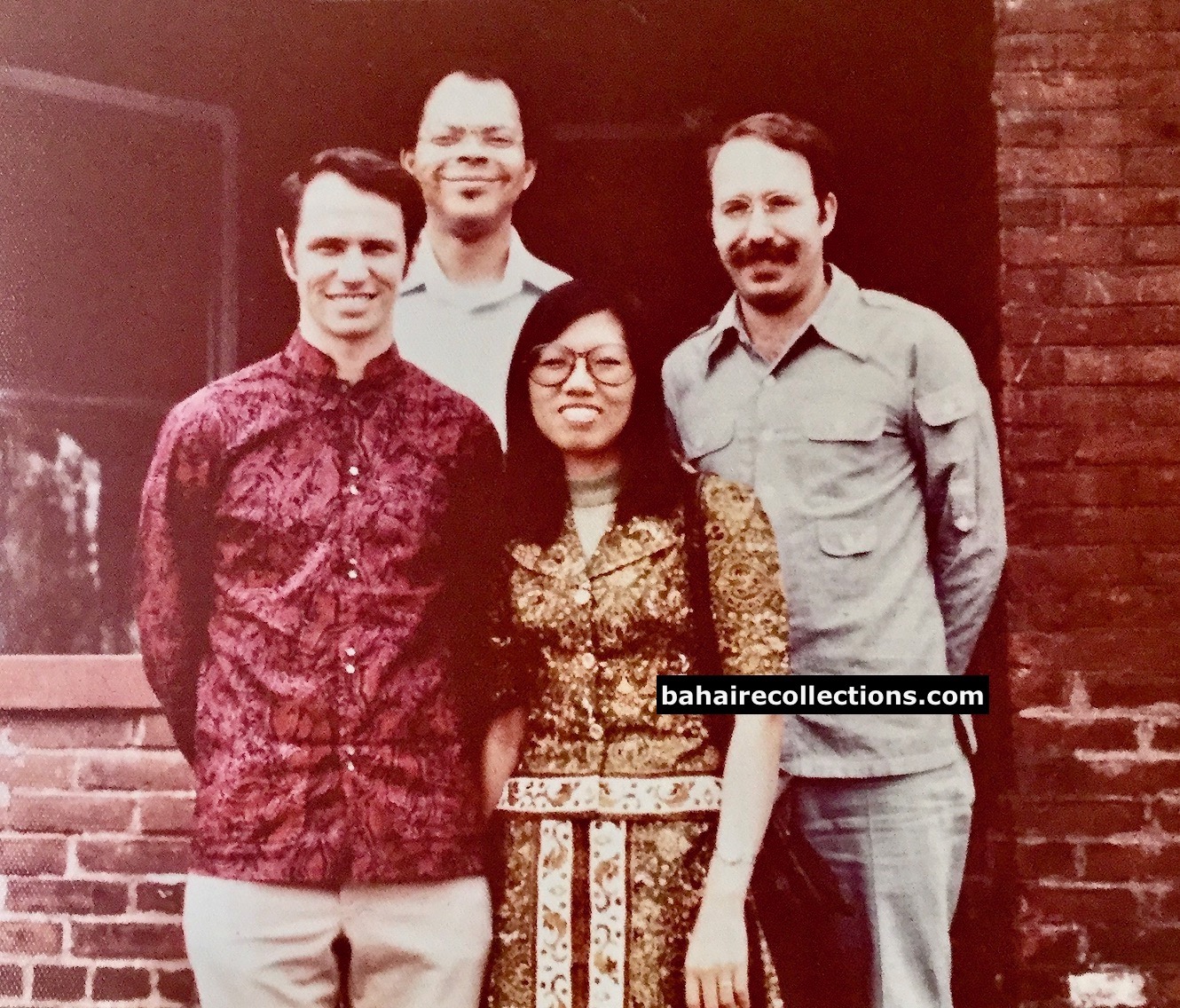
A simple and yet a dignified wedding. Standing at the back left is Edward, representative of the Local Spiritual Assembly. Standing at the right is a witness for the wedding. His wife was another witness who snapped this photo.
It was a simple wedding. In the wedding picture, Ed, a Local Spiritual Assembly member, was present along with the two Baháʼí friends, who came to the rescue! Finally, in 1978, we travelled to Ipoh town in Malaysia, where we had the traditional Chinese tea ceremony to honour Kam Sim’s parents. We have been married 44 years and have one daughter, Jessica who was born May 14, 1982. She lives in Montana with her family. Together, we have been lucky enough to travel all over th e world, working, teaching the Faith. We are now in Albuquerque New Mexico, contributing to the Baháʼí community here in the East Sector.
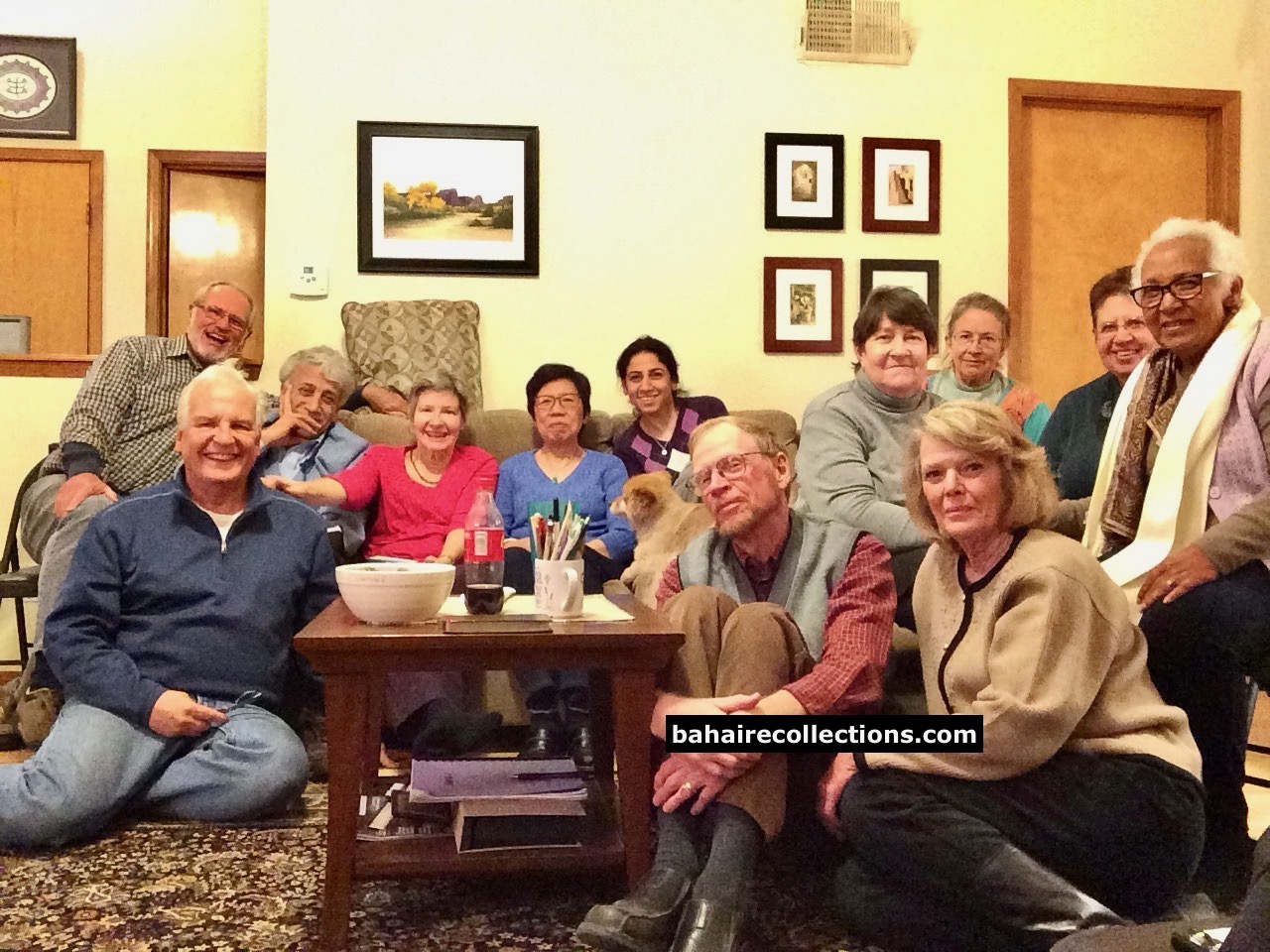
With East Sector Albuquerque Bahá’ís. Matt is seated at extreme left, and Kam Sim is fourth from left

Erik, Jessica and grandson Dailan in Montana, U.S.A.
A word in conclusion
In conclusion, was it grace, the spontaneous gifts, unexpected assistance from God, that brought us all together during those “wonder” years in Malaysia? Of course they were! I hope that my brief memoirs stimulate the readers to think about the episodes in their lives that guided them to the Faith, those chance encounters, the grace given you by Bahá’u’lláh, that put you on the path to becoming a Baháʼí.
Finally, thank you once again for the memories, for the happiness that we shared and your love that cemented us together in contributing to the Faith, creating a community that is literally admired, respected, and held up as a shining example for communities around the world.
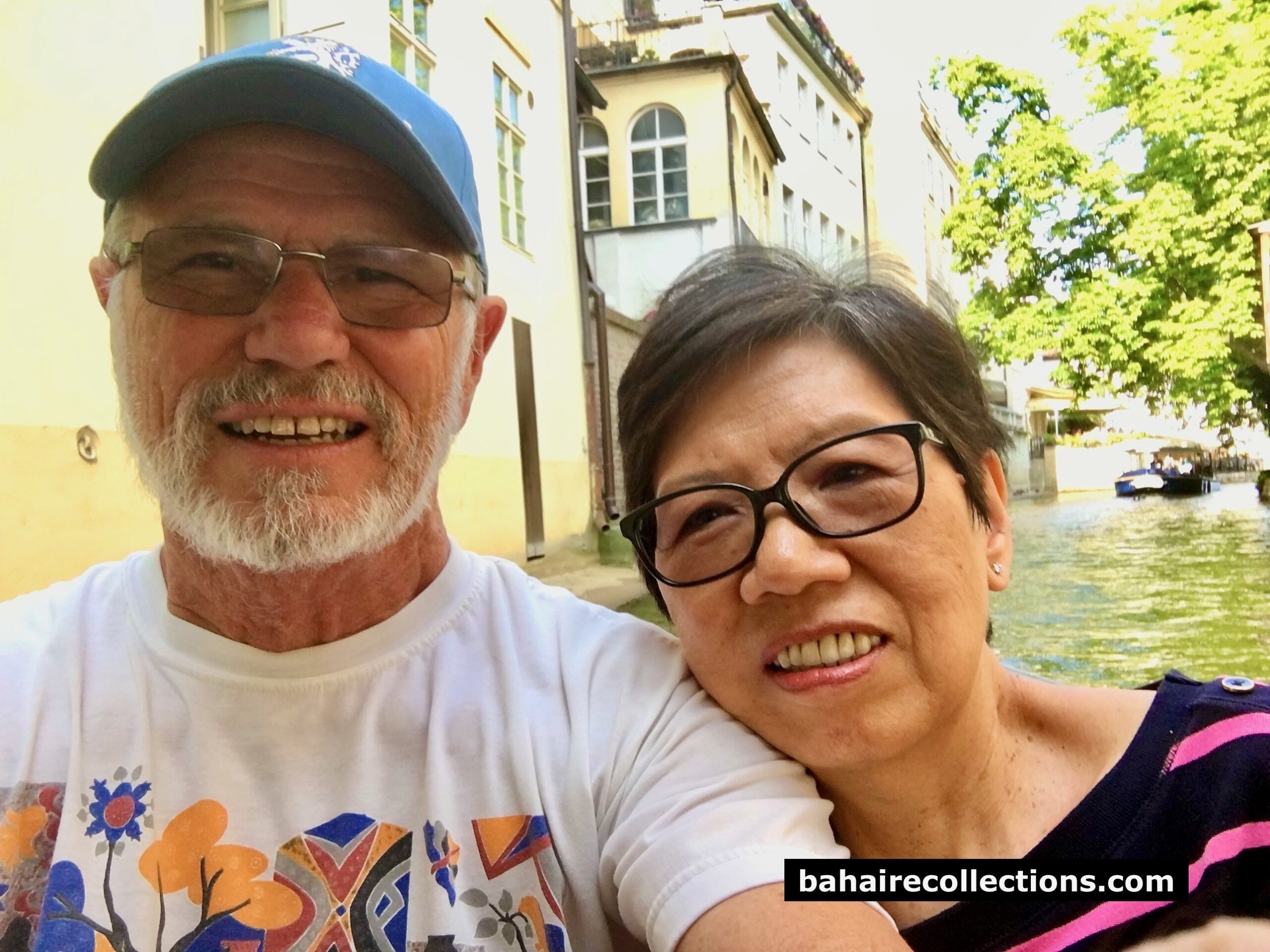
As we are today
Matthew Wagner
Albuquerque
New Mexico
30 April 2022
Copyright@bahairecollections.com
You may leave your comments at: info@bahairecollections.com